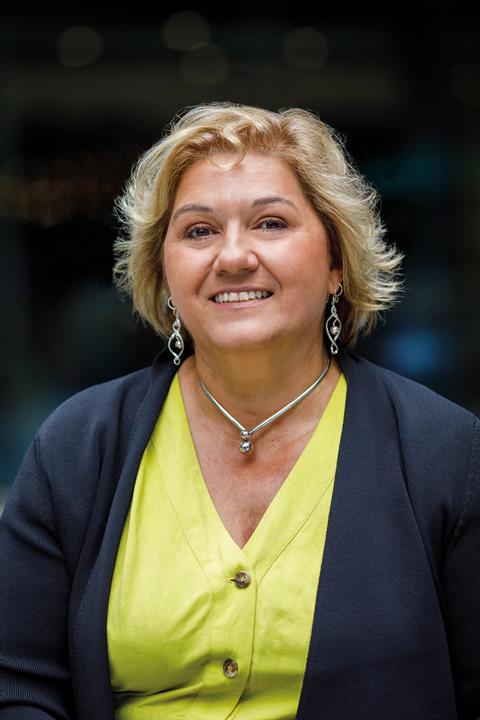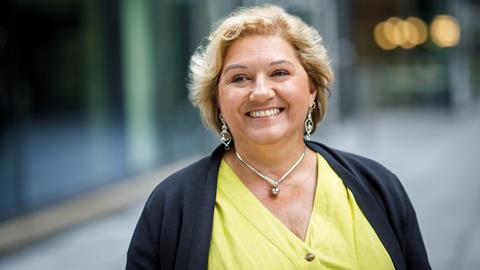Blake Morgan chair Kath Shimmin talks with Eduardo Reyes about swearing, drinking, leadership and missing the diversity bus
BIOG
BORN
Isle of Wight
EDUCATION
Sandown High School, Isle of Wight (1978-1982)
Read law, King’s College, University of London (1982-1985)
ROLES
Articled clerk and solicitor, Slaughter and May (1986-93)
Solicitor and partner, Blake Lapthorn/Blake Morgan, 1994-present
KNOWN FOR
Founded Blake Lapthorn’s banking and finance team (2001)
Elected chair of Blake Morgan (2021)
Before our interview’s first question, Kath Shimmin has made an advance apology for any swearing. ‘A thing I learnt really early in my career was how to swear,’ she explains. That career began in the late 1980s at a firm where the smoking room was a ‘den of iniquity’. In fact Shimmin, now chair of top-50 law firm Blake Morgan, gets through the hour with just two profanities.
‘I swear like a trooper. Why? Because that’s how you got on with the blokes,’ she explains. ‘I learnt to drink and swear and do what all the blokes did. Because… that’s what everybody else did; so if you wanted to get on, then you did. And actually, it was quite fun.’
She had been interviewed for her articles, she recalls, by a partner who she remembers as ‘a brilliant bloke’ and ‘a massive, massive character’.
‘He sort of looked me up and down,’ she says. They chatted and then he asked: ‘Well, where do you want to be? What do you want to get out of your career?’.
‘What I’d like,’ Shimmin said, ‘is I’d like people to actually ask for me by name. I want them to want Kath Shimmin, and not Slaughter and May.’
The partner, Richard Youard (described in his Guardian obituary as ‘one of the towering legal brains of his generation’), clearly warmed to such confidence of youth. Shimmin began her career at what many still regard as the City’s pre-eminent law firm.
The Island
‘I was an Oxbridge reject,’ Shimmin says. Her state school on the Isle of Wight ‘wasn’t a poor school by any means’, she adds. ‘But kids from the Isle of Wight are less likely to go to university than from other parts of the country.’
She went to King’s College London to read law ‘because, having decided I didn’t want to be a doctor, I thought that my parents would find law at least a vaguely credible alternative. But in fact, I never regretted the choice’.
Of the intake of 70 law students that year, as far as she could work out, ‘only two of us were from comprehensive schools’. If that mattered, she recalls, it mattered most at the start. Other people’s overconfidence can be bruising. ‘You’re stepping into a bunch of guys who seem to just know how everything works and you don’t,’ she says. ‘I used to sit there thinking, I can’t talk about that. I don’t know anything about that… I don’t think I felt massively disadvantaged, but you’re just slightly off the pace.’
By her own account, ‘partying hard in the first year’ meant she scraped a third in end-of-year exams. She recalls going home for the summer and thinking: ‘Bloody hell, I’d better do better than that.’ She set herself the discipline of working ‘nine-to-five, Monday to Friday… coming out with a reasonably decent 2:1’.
Was King’s a good preparation for the practicalities of a legal career? Shimmin says yes: ‘The great thing about King’s was that most of what you did was problem-solving. I think I wrote four essays in the whole time I was at King’s. Because mainly what I wrote was reasons… judgments. And then we’d sit in tutorials and argue the toss. So, it was very focused on analysis, using information effectively, understanding the commercial realities that underpin things, much more than… “Write your essay on the esoterics of tort law”.’
Arriving at Slaughter and May, she entered a firm that ‘was still a very chappy… a very male place’. The firm had its first female partner, Ruth Fox, who Shimmin worked for at the start. A few years ahead of Shimmin was Deborah Finkler, now Slaughters’ managing partner, but ‘most of the senior lawyers were men’.
‘Banking in the City in the 1980s was very male,’ she recalls. ‘I didn’t have too much of a problem with it. The only thing that used to irritate me was that they did have a bit of a dress code. Skirts were expected.’ Men could also fall foul of sartorial expectations. She recalls ‘one young man coming in, in a very… hip, brown pinstripe suit’. The man was told: ‘Only accountants wear brown suits. Go home and change.’
Big Bang
The start of Shimmin’s training coincided with the City’s 1986 ‘Big Bang’, the lifting of tight financial services regulations. With Slaughters’ City client base, that meant work at the cutting edge of financial product development. ‘I started doing mortgage securitisations,’ she says, ‘which was incredibly intensive… the capital markets had been opened up by big banks, so there was a lot of money in the markets for people to get into these things.’
'Slaughters had a very good maternity leave policy… five months on full pay. And that seemed like an eternity to me. In fact, it was an eternity, because I realised very quickly I wasn’t cut out for being a stay-at-home mum'
It was ‘great business’, she recalls. ‘But you were making it up as you went on because it had not been done before.’ Shimmin ‘likes to take credit’ for the now commonplace use of ‘master definition schedules’. ‘You were just working out how to do stuff that hadn’t been done before,’ she says. As a period it was ‘fun. Exhausting, but fun’.
In 1993 she and her husband had their first child, a son. ‘By all standards at the time,’ Shimmin says, ‘Slaughters had a very good maternity leave policy… five months on full pay. And that seemed like an eternity to me. In fact, it was an eternity, because I realised very quickly I wasn’t cut out for being a stay-at-home mum.’
But on returning from maternity leave, she found ‘once you go back, there’s no half measures’. With a full-time nanny, the logistics of a City career were manageable. ‘But is that working for me?’ she asked herself. ‘I thought about it quite a lot and decided that there was no point trying to do the Slaughters world at half cog. Because you can’t. You’re all in or you’re all out.’
In 1994 she was offered a job at Blake Lapthorn in Southampton and resigned from Slaughters. (The firm, she recalls, waived the commitment to repay maternity leave.) That permanent move to the south coast was not easy to effect. It took her husband a year to find a job in the south so he continued to work in London. Shimmin and their son moved in with her mother, now living in Bournemouth, and she commuted to Southampton.
Living and working with AI
How will artificial intelligence change the role of a lawyer at a firm such as Blake Morgan? Chair Kath Shimmin says it will change lawyering, but it has its limits. ‘Yes, an AI [product] can tell you what the law is. An AI can tell you how many people went one way.’
However, she adds: ‘I could sit down and talk with a CEO and go, “Right if you do it like this, you’ve got these things to consider. You’ve got relationship issues here, are you sure you want to [do this]?”’ It is those ‘granular discussions’ which the client needs, ‘which you can’t yet do with an AI’.
There is a clear impact on the training and development of junior lawyers, though. ‘A slight worry is that I don’t know how we’re going to train young lawyers if they’re not cutting their teeth on drafting documents and checking documents, and writing emails, and getting to know their way around a transaction from the bottom up, because now what they’ve been doing is presenting a finished article,’ she says.
‘The whole way we teach law is going to have to change, because so much of what we currently teach lawyers, they don’t need to know any more.’
Rail privatisation
As a Slaughters trainee, Shimmin had worked on privatisations. Arriving at Blake Lapthorn she was straight on to the privatisation of the railways. ‘Really complicated,’ she recalls. And, like securitisation work, ‘again, messy, you make it up as you go along’.
‘Vast master documents’ were produced by firms such as Clifford Chance, she says. ‘Then our job was to advise the various elements of what was then British Rail on the various bits of the contracts they would have to sign up to. So, we were advising a number of the train operating companies. And doing their rail access contracts… the station access contracts and the depot access contracts… the track access contracts.

‘I had a lovely moment when I realised that I was looking at the track access … and that they’d got their sums wrong for their delay regime. And you couldn’t use the formula to produce a positive number. So, I’m thinking, “That’s very nice for Network Rail; I don’t think it’s too good for the rest of us!”.’
Shimmin and her husband wanted another child. She talked to Blake Lapthorn’s head of corporate, Caroline Williams. Shimmin told Williams: ‘I’m thinking of having a second child but I want to be a partner in the firm, what would you suggest about the order in which I do these things?’ Williams replied: ‘I think you just need to do what feels right.’
It was 1997 and Williams put Shimmin up for partnership while she was on maternity leave.
It felt like the world of professional work was changing, though Blake Lapthorn did not have Slaughters’ resources: ‘I came back after a very short maternity leave because once you’ve got one child and a full-time nanny you quickly realise that £54 a week statutory maternity pay doesn’t go very far.’
There was not quite the same ‘all in, or out’ attitude that Shimmin had experienced at Slaughters. ‘I went back after 14 weeks,’ she recalls, ‘and they just said, “Right, fine, here’s a bunch of precedents, we don’t really want to see you until the end of summer”. So, basically they paid me to do very little for three and a half months. It was a glorious summer, so I had a fantastic time.’
It was also a chance to do some thinking about what she would bring to the partnership. She decided: ‘I think we need a proper banking department here.’ That, she thought, would distinguish Blake Lapthorn from most regional firms, which only had corporate lawyers who ‘do a bit of banking on the side’. Shimmin began to attract more banking work, establishing a proper team in 2001. She resolved: ‘We’re going to have a proper banking team now, and we’re going to be on bank panels, and we’re going to be known as a banking and finance team, not as some corporate lawyers who happen to do a bit.’
Building a banking team in Southampton meant, and still means, identifying what will lure ambitious lawyers from the City. ‘It’s a complex pitch,’ Shimmin explains. ‘It’s not a money pitch, it’s about control over your own career.’
She might have joined Slaughters with the idea that clients might ask for her by name, but actual exposure to clients at the firm was limited for the first few years. At Blake Lapthorn she could promise: ‘From the start… you come to meetings with me, you meet clients with me, you do [business development] with me. You get to do the whole thing, you don’t just get shown a tiny, tiny snippet of it. It’s about taking a very personal interest in the development of the individuals that you acquire.
‘I will say to people, “Look, if you want to go and do the City thing, fine, but don’t stay too long, because the longer you stay, the harder it is to get out.”’ What does she mean by that? ‘Trust me, I don’t want a nine-years-qualified lawyer who’s been devilling in a back room for nine years because you’re far too expensive to me and you don’t actually know anything useful.’
Retention is key for a regional practice like this, she says. ‘I need to keep them. So, I need to make it worth their while to stay. Not just or only financially but in every sense.’
Leading the way
Management responsibilities are quite different to the demands of creative thinking on the law, I observe. How has Shimmin found the shift? ‘It’s a different kind of creativity,’ she replies. ‘I’ve always seen myself as one of these slightly blunt, tactless individuals who calls a spade a spade and couldn’t tell if somebody is upset if they were, you know, grieving in my office. Actually what I’ve discovered is, you can learn a lot of that… I’ve had some great coaching over the years, I’ve learned a lot. Once you start to get into how people tick and what do I need to bring to this situation in order to make it operate in the way I think it needs to, it’s fascinating.’
Along with corporate and banking, the firm has a strong private client practice. It did, though, shed a well-respected personal injury practice. Before and after the 2014 merger with Cardiff-based Morgan Cole, to form Blake Morgan, the firm tried out structures to deal with the conflicts that arose from the PI practice.
Shimmin says: ‘Because of the nature of the PI work, it just didn’t fit, in terms of the business model, with the way the rest of the firm, including the rest of the private client team works…. it just got to a point where you’ve just got to make a decision and say, “Look guys… we can’t give you the investment that you need to flourish, and so you’re better off being somewhere that can.” It’s not an easy decision.’
'Like it or not, there is still a degree of misogyny and bias out there that needs to be called out and dealt with'
In 2021 she won a contested election for chair of Blake Morgan. ‘It’s a proper election,’ she says, with a shortlist of two emerging from soundings within the partnership, each candidate having produced a personal statement.

As a woman in a leadership position in the law, does she consider herself a feminist? By her own definitions, yes, she says: ‘Like it or not, there is still a degree of misogyny and bias out there that needs to be called out and dealt with. I think one of the biggest parts of feminism now is actually working with men to get them to understand what the right relationship between men and women in their individual careers is.’
A proper approach to parenting that would give rise to greater equality, she says, would see men taking a bigger role. ‘One other thing people get asked quite a lot is, “Do you think that you’ve been a trailblazer?”,’ Shimmin reflects. ‘The honest answer is, no I don’t think I have. I actually think I missed all the diversity buses by about 10 minutes.’
What’s next for the firm? ‘It’s quite difficult to pull out one or other thing,’ she answers. ‘I remain hugely committed to how we get more diversity, both in the firm and across the profession… We look at that from, you know, gender, LGBTQ, race and ethnicity, neurodiversity, other forms of disability. I’ve probably missed a few out, but you have to look at it through all those different lenses… you have to be able to present a law firm that looks like the people that you’re trying to attract, and you have to be able to attract everybody if you want to get the best possible workforce.’
People treat these points on diversity as ‘obvious’, she says. ‘If it’s so obvious, you know, why aren’t we more diverse?... If it’s so obvious, why can’t we solve what happens to women when they get to childbearing age and decide not to come back into the profession? If it’s so obvious, where are all the black faces in our regional law firms? And I’ll be honest, we are under-represented there, and I want to see that change. And we’re working very hard on it. We’re building some really good partnerships with a number of institutions now to really move the dial on that, but it takes a long time.’
Photography: Darren Filkins





































No comments yet